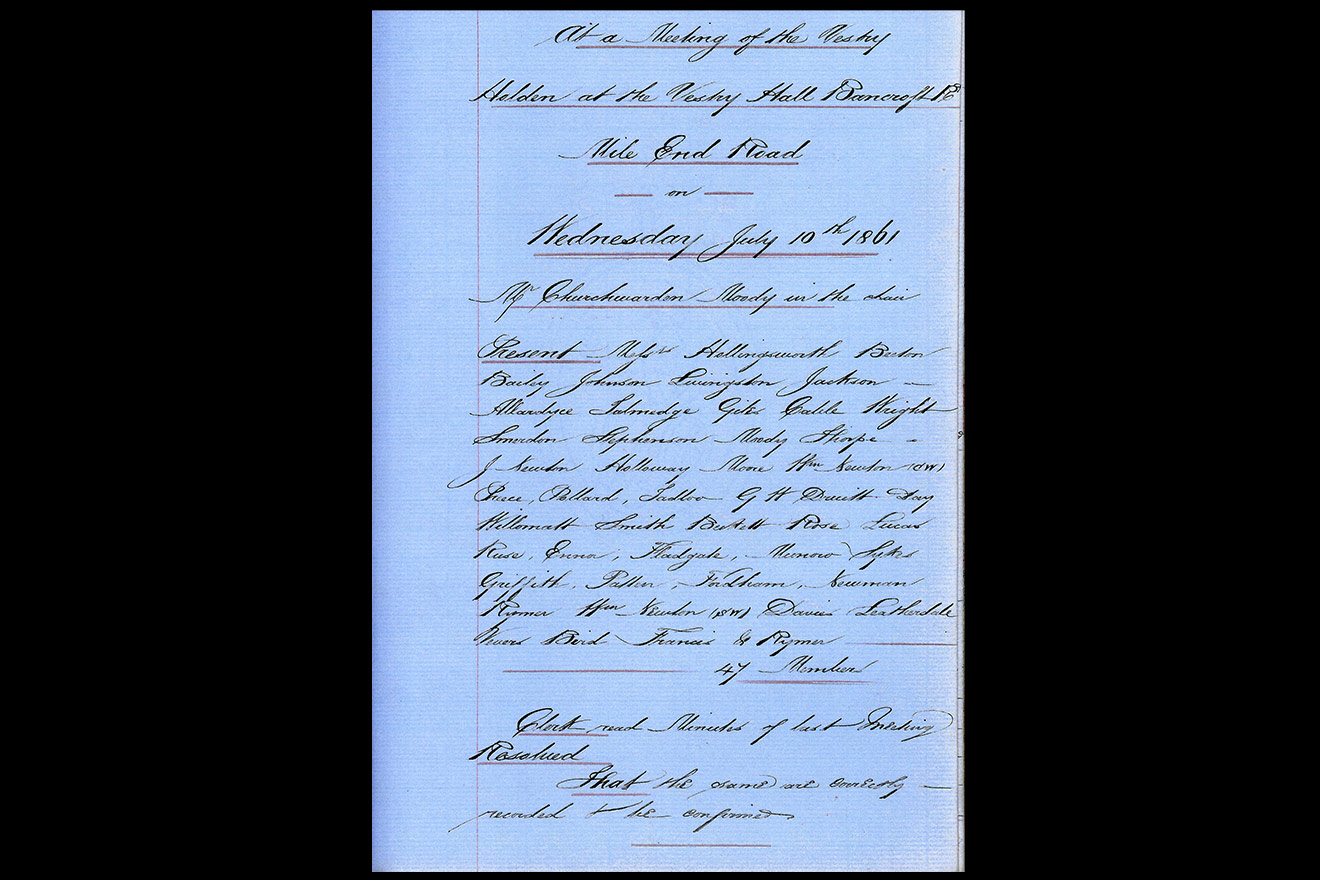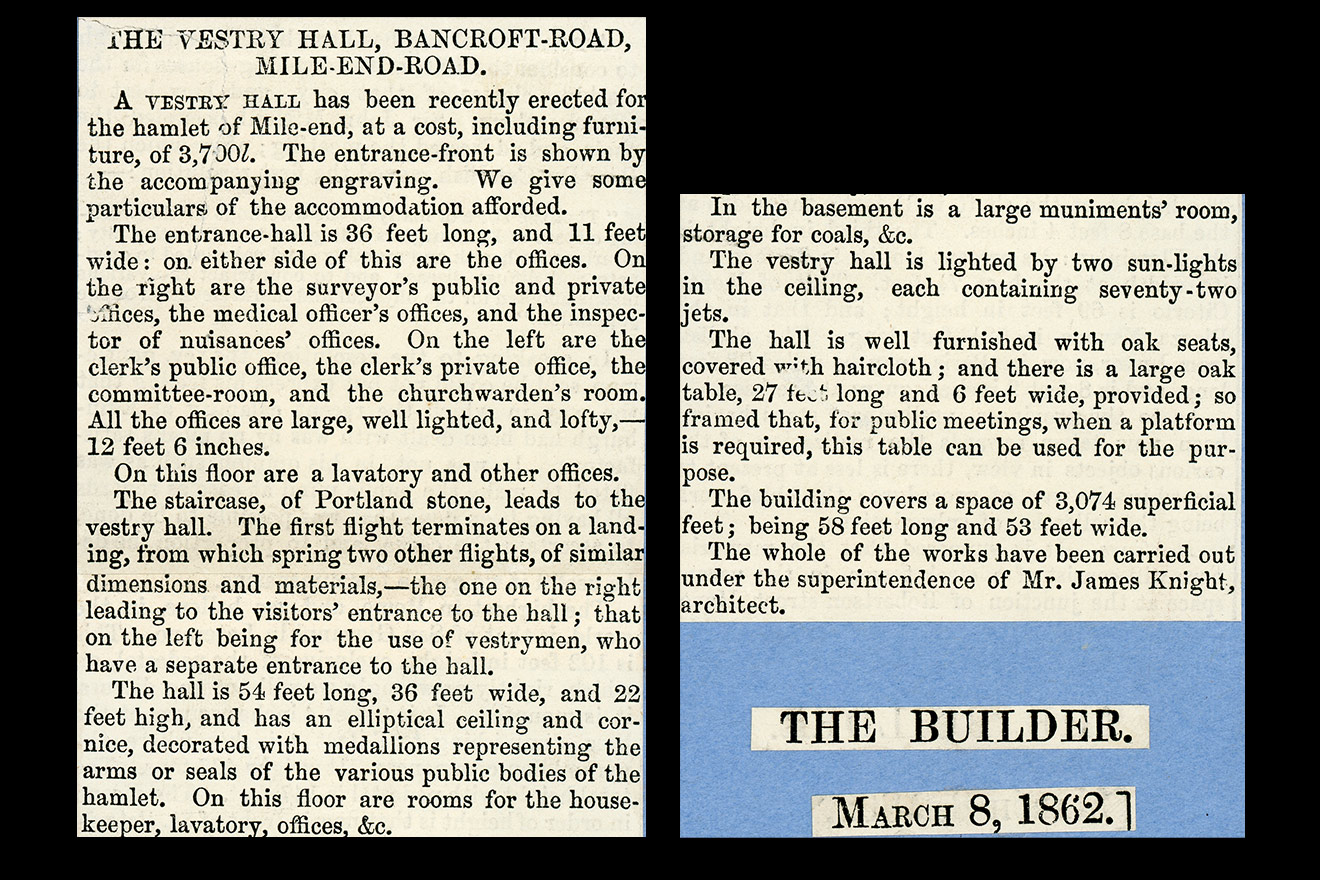From local Town Hall to Local History Library & Archives: a short history of our service and premises, 1861-2015
To mark the 50th anniversary of the creation of the London Borough of Tower Hamlets in 1965 and the establishment of a distinct and central local history service for the new borough, this exhibition focuses on the history of Tower Hamlets Local History Library & Archives and the 19th century grade II listed building which houses the service and collections.
Vestry Hall of Mile End Old Town, 1861 - 1901
[Illustration of the new Vestry Hall for the Hamlet of Mile End, 'The Builder', 8 March 1862]
The building at 277 Bancroft Road, which houses the collections and services of Tower Hamlets Local History Library & Archives, started life as a vestry hall, effectively a local town hall for the area of Mile End Old Town. The Hamlet of Mile End Old Town had for centuries been the local administrative area, being a self-governing hamlet within the very large parish of Stepney. Tenders for the new vestry hall and offices were submitted in 1860 and the building was completed in 1861 at a cost of £3,700. The last meeting of the Vestry of the Hamlet of Mile End Old Town at its premises at the Town House, Mile End Road took place on Wednesday 12 June 1861 and its first meeting at the new, purpose-built vestry hall took place on 10 July 1861.
Over the next 40 years the building was used not only for local governance but also as a base for meetings of the Board of Guardians who oversaw the administration of the Poor Law and Mile End Workhouse. Mile End Workhouse was located next door to the Vestry Hall and later became Mile End Hospital.

Mile End Library, 1902 - 1965
In 1901 the reorganisation of London government resulted in the abolition of smaller authorities, such as hamlets, in favour of the formation of the new, larger Metropolitan Boroughs. The area of present day Tower Hamlets was arranged into three new Metropolitan Boroughs: Poplar, Bethnal Green and Stepney. Mile End Old Town was one of a number of areas amalgamated to form the Borough of Stepney. The new administration chose to have its offices in the former Limehouse and St George’s town halls. The former vestry hall on Bancroft Road became Mile End Library, a public lending library for the new borough of Stepney, and was officially opened on Tuesday 9 January 1902.
Between 1902 and 1965 the building housed a range of library-related services and underwent various structural changes.
Public Services at Mile End Library
Stepney’s first Borough Librarian was a pioneer, Albert Cawthorne, who initiated a partnership with the Home Reading Union leading to the formation of the first ever reading circles in public libraries during 1903. These were an early forerunner of reading groups, common in public libraries today. At the time, these reading circles would have been extremely innovative – their aim was to guide readers of all ages in their choice of books and facilitate discussion, resulting in a greater understanding of the text and around a particular subject matter. The topic chosen by the reading circle at Mile End Library to study over the winter of 1903-1904 was ‘The History of England’s Naval Power’. There were 21 members.
Cawthorne also advocated the provision of free public lectures. The first lecture at Mile End Library was given on 6 December 1904 on ‘Infectious Diseases, their Cause and Prevention’. However, topics also included foreign travel, history, politics and economics. By 1925, Stepney public libraries were providing an average of 50 lectures per year (which included series of lectures and University Extension Courses) – this was significantly more than any other London Borough at the time.
Mile End Library provided ‘Story Hours’ for children, run in partnership with the local schools from 1926. During the same year, a series of weekly talks for adolescents between the ages of 16 and 25 were initiated at Mile End Library in conjunction with the Stepney division of the Old Scholars’ Club.
From the late 1940s, the libraries in Stepney also started organising other clubs and activities, e.g. an ‘old time dancing’ club was formed at Mile End Library during 1949. In the 1950s and 60s, the libraries started screening films - 186 people attended a screening of ‘Cat on a Hot Tin Roof’ at Mile End Library in 1961. During the late 1950s, the Borough Librarian, who at this point was Herbert Ward, also began to give regular tours of Mile End Library to a variety of groups, including student nurses from the neighbouring Mile End Hospital.
In 1947 a gramophone record library was established at Mile End Library – it wasn’t unique, but was fairly uncommon at the time and demonstrated how the library was keen to facilitate popular tastes and the growing public interest in various cultural activities.
The first exhibition at Mile End Library took place during 1957 in partnership with the Underwater Swimming Club of Great Britain and consisted of a display of underwater photography. Other exhibitions included ‘From Stibenhede to Stepney: a thousand years of history’, which displayed the library’s collection of prints, photographs, paintings, newspaper cuttings and maps relating to the history of the borough, which attracted over one hundred people each day. The exhibitions increased in popularity throughout the 1960s. For example, an exhibition titled ‘Stepney Housing Progress’ during 1960 gained considerable publicity, both on television and radio and in the local and national press, attracting a total of 4507 visitors.
Mile End Library also acted as a community hub – by 1957 its lecture hall and rooms were being used regularly by a wide range of organisations, including political parties, trade unions and friendly societies.
The archives, held here, of the Stepney Borough Public Libraries’ Committee reveal all of these details and more.
Structural Changes
There were two major extensions to the building after it became a library:
• The adaptation of the building in 1905-1906 to enable the addition of a ground floor lecture hall with reference library above, facilitated through receipt of a Carnegie grant.
• The adaptation of the building in 1936-1937 which effectively doubled its size and was undertaken to create a children’s library on the ground floor and an extension to the main lending library above.
The children’s library was opened in the 1930s by author Walter de la Mare, used as a first aid post in the Second World War and finally closed in the 1980s. The room is now used as Tower Hamlets Local History Library & Archives’ Education Room.
Tower Hamlets Central Library (Bancroft Library) 1965 – early 2000s
In 1965 the three boroughs of Poplar, Bethnal Green and Stepney merged to become the London Borough of Tower Hamlets. The building became the Central Library for the new borough and the local studies collections held by the former borough libraries of Poplar, Bethnal Green and Stepney (the latter already housed in the building) were merged to form a local history library and archives service based in the old reference library room. The central reference library for the new borough was established at Bethnal Green Library.
In the 1980s the first archivist was appointed to help manage the borough’s archive collections, in 1988 an archive strongroom was created by adapting the old lecture hall. It continues to be used to house the archive material to this day.
Early 2000s - 2015
In the early 2000s the borough’s lending library services were re-organised and rebranded as Idea Stores, the first of which opened in Bow in 2002. As part of this process the lending library and mobile library services which shared the building with the local history service were gradually relocated to other council premises in the borough leaving Tower Hamlets Local History Library & Archives as sole occupant.
As with many other local authority library and archive services the 21st century has brought difficulties through increasing budget constraints. Tower Hamlets Local History Library & Archives faced a significant challenge in 2008 when an offer for the building was received by Queen Mary, University of London and it was proposed that if the sale went ahead collections be relocated off-site. A large public campaign was successful in ensuring the council retained the building and the Local History Library & Archives within it.
The council has since invested £750,000 in essential work to upgrade the premises, including the restoration of the building’s roofs. This investment also helped facilitate important health and safety improvements including the installation of a ramp, new lift and fire alarm system. The improvements have helped to make the building fully accessible to visitors, including wheelchair users.
Seven years later, on its fiftieth anniversary, the small team within the building continue to deliver free access to Tower Hamlets Local History Library & Archives’ extensive collections relating to the history of the East End of London. The building houses an awe-inspiring reading room for visitors to carry out research using the historical library and archive collections, a large entrance hall used for the display of relevant exhibitions and an education room for heritage-based workshops, film screenings, talks, training and other events.



